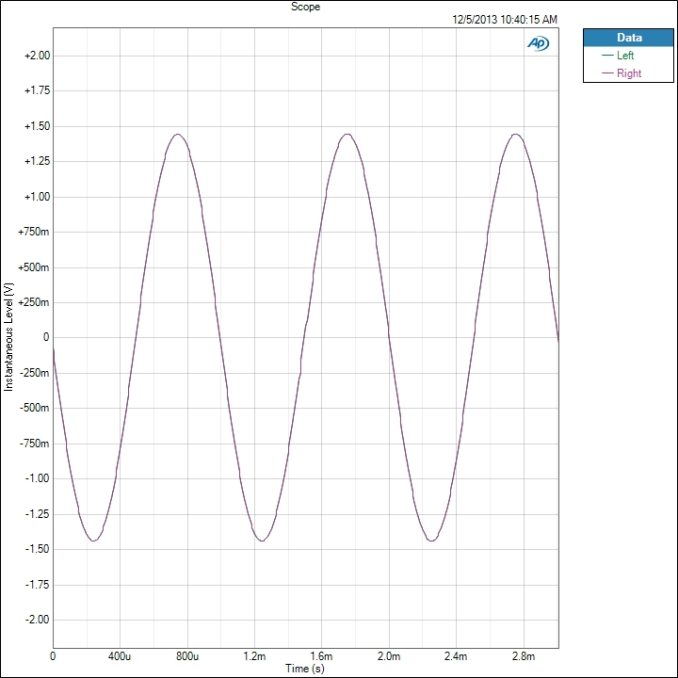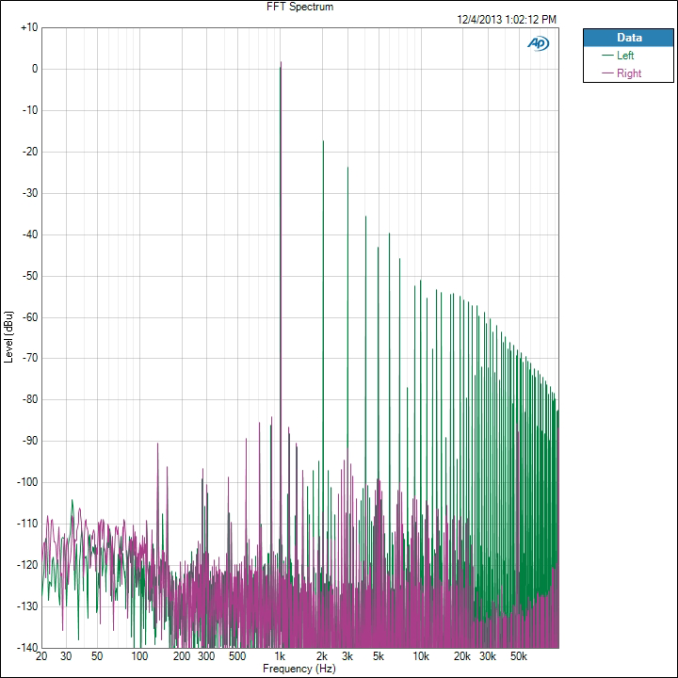Smartphone Audio Quality Testing
by Chris Heinonen on December 8, 2013 5:15 PM EST- Posted in
- Smartphones
- Audio
- Mobile
- Tablets
- Testing
THD+N is a measure of the total harmonic distortion and noise compared to the signal. The lower the number, the less distortion and noise there is relative to the fundamental frequency. THD+N is measured by driving a 1 kHz sine wave at maximum volume. Because there is always some inherent background noise, the THD+N is almost always lowest at maximum output so that is used for the measurement.
There are two results that we take from this: a sine wave and a FFT spectrum. On the sine wave both channels should line up perfectly, and it should be as close to an accurate sine wave as possible. On the FFT we want to see a peak at 1 kHz and everything else as low as possible. The most common artifact you will see are harmonic sidebands at multiples of 1 kHz.
For an example of data that looks good, here is the sine wave of the iPhone 5. We see a sine wave that is good, with channels that overlap perfectly and no deviation. This is what we expect to see.
Now for a different example we look at the Nexus 5. Run at maximum volume we see that the left channel is clipping in the sine wave. Likely the power to the headphone amplifier is not enough to drive both channels and so this is the result. UPDATE: Tested this with 4.4.1 and no change.
The iPhone 5 produces a THD+N ratio of 0.003134% while because of the clipping, the Nexus 5 is producing 13.789197%. Any level over 1% is considered to be past the clipping point of an amplifier and it seems that the Nexus 5 cannot be driven at maximum volume. I tested two samples to verify, and on both the performance is identical.
Now if we look at the FFT for this test, we see how this distortion is showing up. First, the iPhone 5 is very quiet.
There is a 2 kHz peak that is -93 dB below the fundamental frequency, and the 3rd harmonic at 3 kHz is over -109 dB below it. All the harmonics past that are at -120 dB below the fundamental tone. There is some noise out at 50 kHz but this is so far past the level of human hearing that it is safely ignored. Now the Nexus 5 FFT.
We see the right channel, which didn’t clip, looks good. The 2nd harmonic is -111 dB and the 3rd harmonic is -93 dB. On the left channel the 2nd harmonic is only -18 dB and the 3rd harmonic is -24 dB. Even at the 9th harmonic we are still only -52 dB below the fundamental tone. This is causing these incredibly high THD+N numbers that we are seeing on the Nexus 5. We will see more detail of this on a later test as well.
We also chart THD+N vs. Frequency. Here is the chart for the Note 3.
We see that THD+N is basically right below 0.08% for the whole spectrum. It moves up and down slightly, but is very constant. Now here is that Nexus 5 data.
We see that the right channel is around 0.01% THD+N while the left channel, the clipped one, is over 3%. If we ran the Nexus 5 at a lower volume level we would see totally different results, as you’ll find out later, but this is how devices are typically measured.
















188 Comments
View All Comments
dylan522p - Sunday, December 8, 2013 - link
Just because you have a good DAC,doesn't mean you have great audio. S4 has a great DAC but it can't even power high impedence headphones.cjl - Monday, December 9, 2013 - link
The S4 powers moderately hard to drive headphones just fine - sure, it won't drive something like an HD650 adequately, but the majority of consumer headphones out there will go plenty loud driven straight out of an S4. That having been said, it would be nice if it had a bit more power for hard to drive headphones.oktrav - Monday, December 9, 2013 - link
I can't believe how many people on the internet are singing this song... Does it really matter who makes the DAC if the output sounds like crap? The DAC is just one of many components that affect the sound quality. You can have the best components in the world and still produce absolutely dreadful sound. Ask any wannabe audiophile who's dabbled in assembling home systems out of separates. This is akin to saying that your car must be very powerful BECAUSE it has Bosch coil packs --and Bosch makes the BEST coil packs (just play along for the sake of the analogy, I'm not actually asserting that Bosch makes the best coils --I don't know).nomopofomo - Sunday, December 8, 2013 - link
So glad you went into such depth.Best case scenario, the public and manufacturer are both made aware of the flaws.
drwho9437 - Sunday, December 8, 2013 - link
This has been needed badly for some time. Phones displacing media players this matters a whole lot. To me far more than actually anything else about a phone.probedb - Sunday, December 8, 2013 - link
You also have to remember with some measurements about what is actually audible and what isn't. It's crazy seeing people moaning about nanoseconds of jitter on DACs yet they're quite happy with milliseconds of the equivalent of jitter on vinyl. Then again some of these companies sell ethernet cable at £1600/m and claim it makes a difference to sound ;)matagyula - Sunday, December 8, 2013 - link
Great to see something like this on anand!I would like to see some older high-end phones compared to the ones we have now - for example the Nokia N900, or maybe even some of the ooold Sony-Ericsson Walkman phones (W810 and up). I'd find such comparison interesting ^^
chubbypanda - Monday, December 9, 2013 - link
Great stuff Chris!I was also wondering if it's possible to add some ancient phone with cult following from audio geeks. You know, Nokia N91 and similar. According to some, sound quality on the phones were never better, so that'd be nice to see what is really happening.
wrkingclass_hero - Sunday, December 8, 2013 - link
So, how long before Arstechnica "discovers" the audio problems with the Nexus 5?crabperson - Sunday, December 8, 2013 - link
YES! Thank you so much for doing this, its awesome. I didn't realize audio/amp quality was a huge thing until I upgraded my headphones. Being able to hear the difference between the same audio file on two different devices made me realize how little manufacturers care about audio quality.Then using an FM transmitter in my car showed me how some devices can't pump out enough power over the headphone jack. My Galaxy Nexus has pretty good audio quality (and does optical audio out through the dock, also awesome) served me fine for pumping up music through the FM transmitter. The Galaxy S3 I'm temporarily using does not though, and produces noticeable clipping at max volume. It also isn't properly shielded and when charging there is interference on the headphone jack (something you should also test if you haven't thought of it). I'm looking at upgrading if I can't fix my Nexus, and hope the HTC One is as good as it in terms of audio quality (with Beats disabled of course).